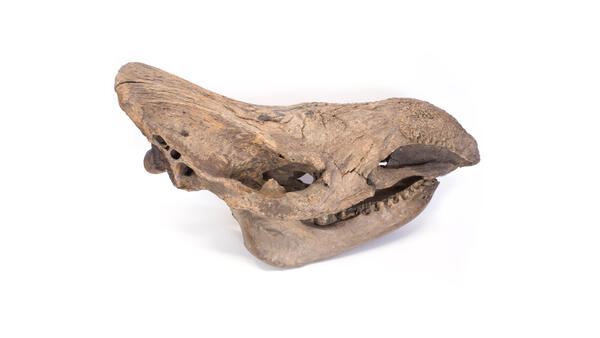The collection of the Regional Museum of Local History contains a skull of a woolly rhinoceros — these animals appeared on the planet more than 100 thousand years ago. They lived throughout Eurasia: from the British Isles to Primorye, but most of their remains were found by archaeologists at excavations in Siberia.
It is known that woolly rhinos did not live in Africa, but why they did not move to this continent remains a mystery. Other large animals could move from continent to continent.
In size, the woolly rhinoceros was slightly inferior to the mammoth: its body length could reach three and a half meters, and its weight was three tons. There were two horns on its head: a slightly longer front and a short rear. The length of the front could exceed a meter. The animals were protected from the cold by a long thick brown coat and a hump on the back with a large supply of fat. The body consumed it in case of starvation and did not allow the individual to die.
Rhinos were not herd animals — they kept one by one and preferred to live near water, for example, in wide floodplains of rivers or on the shores of the lakes. There it was easier for them to find food for themselves: shoots of shrubs, as well as bark and young leaves of willow, alder and birch.
On average, woolly rhinoceroses lived 40-45 years. Scientists had long believed that they died out before the mammoths — about 15-20 thousand years ago. But in 2008, Russian paleontologists found bones of a rhinoceros that lived about 9 thousand years ago in the Novolyalinsky district of the Sverdlovsk region.
In Siberia, the remains of a woolly rhinoceros were found at the late Paleolithic sites of Malta and Buret in the Usolsky district of the Irkutsk region. Not only bones, but also animal horns were found there, which was a rare find, since the horn of a woolly rhinoceros was usually preserved worse than bones.
Archaeologists have found bones of woolly rhinoceroses at ancient man sites much rarer than those of mammoths, but images of creatures resembling a rhinoceros are found in rock art. As in the case of mammoths, there are several assumptions as to why the animals became extinct. Most likely, this is due to climate changes and the active hunting of ancient people.
It is known that woolly rhinos did not live in Africa, but why they did not move to this continent remains a mystery. Other large animals could move from continent to continent.
In size, the woolly rhinoceros was slightly inferior to the mammoth: its body length could reach three and a half meters, and its weight was three tons. There were two horns on its head: a slightly longer front and a short rear. The length of the front could exceed a meter. The animals were protected from the cold by a long thick brown coat and a hump on the back with a large supply of fat. The body consumed it in case of starvation and did not allow the individual to die.
Rhinos were not herd animals — they kept one by one and preferred to live near water, for example, in wide floodplains of rivers or on the shores of the lakes. There it was easier for them to find food for themselves: shoots of shrubs, as well as bark and young leaves of willow, alder and birch.
On average, woolly rhinoceroses lived 40-45 years. Scientists had long believed that they died out before the mammoths — about 15-20 thousand years ago. But in 2008, Russian paleontologists found bones of a rhinoceros that lived about 9 thousand years ago in the Novolyalinsky district of the Sverdlovsk region.
In Siberia, the remains of a woolly rhinoceros were found at the late Paleolithic sites of Malta and Buret in the Usolsky district of the Irkutsk region. Not only bones, but also animal horns were found there, which was a rare find, since the horn of a woolly rhinoceros was usually preserved worse than bones.
Archaeologists have found bones of woolly rhinoceroses at ancient man sites much rarer than those of mammoths, but images of creatures resembling a rhinoceros are found in rock art. As in the case of mammoths, there are several assumptions as to why the animals became extinct. Most likely, this is due to climate changes and the active hunting of ancient people.



